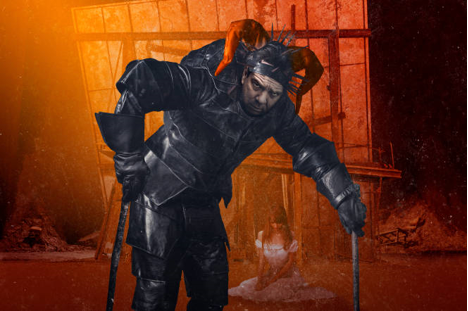Margherita & Risurrezione at Wexford Opera
Image taken from the Wexford Opera website
Doctor Tom Walsh must have known the best medicine to cure all of his patients, because it was he and a group of opera lovers that founded the Wexford Opera Festival in 1951 and indeed he became the Festival’s first Artistic Director. Thereafter, some notable artistic directors have come and gone, namely Brian Dickie pre Glyndebourne and Elaine Padmore pre Royal Opera House. The current Artistic Director is David Agler, who has been in the role since 2005 and the Chairman is the wonderful Ger Lawlor who is always at the front door to meet and greet patrons as they arrive. The new Wexford Opera House has been rebuilt on the same site and was opened in 2008. The Festival indeed is a marvel of creation, with the wonderful Irish people always ready to greet its visitors. Never far away is the wonderful smell of the Lobster Pot pub and salt from the Atlantic Ocean nearby.
Every year the Festival finds three new and usually interesting operas, sometimes operas of real worth that enter the more main stream repertoire. This year two operas were most noteworthy, namely Margherita by Jacopo Foroni and Risurrezione by Franco Alfano. Both operas were passionately performed, with the Margherita providing mid-19th century Italianate music and Risurrezione providing an early 20th century musical drama.
The Italian, Jacopo Foroni, died early at 33, spending most of his working years in Sweden, where he was a Conductor and Composer. He composed four operas, of which Margherita was his first at the age 23 in 1848. The music follows the lines of Composers such as Bellini and Donizetti and was conducted by the American, Timothy Myers, who controlled the evening well, but overall gave us a somewhat wavered performance, which at times cried out for extra pace.
The Director, the German Michael Sturm, gave us a joyful easy production based in an old Italian town with broken walls and most notably a washing line with rather old fashioned underwear hanging from it. The most impressive singing came from the two lead female parts, namely the Italian mezzo soprano, Alessandra Volpe, who sang the title role of Margherita (who is in love with Ernesto) and the soprano, Giuliana Gianfaldoni, sings Giustina, Ernesto’s sister. Volpe has a deep, sultry, impressive sound and Gianfaldoni has a light, but rich voice with a bell like quality. Their Act 2 duet together was beautifully sung.
The male roles were somewhat varied with the Ernesto being an unattractive American tenor of Andrew Stenson, the Conte Rodolfo being a varied pitch Ukrainian, Yuriy Yurchuk, who boasts an attractive baritone sound, Ser Matteo being a deep baritone name sake, Matteo d’Apolito and an elegant bass baritone of Filippo Fontana. The attractive sets were designed by Stefan Rieckhoff and the only small gripe was the lighting of D.M. Wood, who occasionally left principal singers in the dark.
Image taken from the Wexford Opera website
However, it is the Alfano opera of Risurrezione that really made the whole trip worthwhile. Franco Alfano was born in Naples in 1875 and lived for nearly 80 years. He is best known for having completed the Third Act of Puccini’s opera, Turandot, in 1926, but had considerable success with several of his own works during his lifetime. Risurrezione was first performed in Turin in 1904 and was based on the novel, Resurrection, by Leo Tolstoy. The opera required extensive revision between its premier and its final addition published in 1910 with the cuts reducing the music score page numbers from 358 to 267. Rodney Milnes wrote in Opera Magazine in 1985 that ‘the opera’s ambitious setting of Tolstoy’s novel is one of the more satisfying Italian operas languishing in the long shadows cast by Puccini’.
It is a story of love and redemption, which takes place in Russia and Siberia at the end of the 19th century. Prince Dimitri falls in love with Katiusha and they become lovers just before he leaves for war. Katiusha becomes pregnant, but when anxiously waiting for his return by train, sees Dimitri with another lady at the station. After the death of her child she becomes a prostitute and is accused of murder and deported to Siberia. However, Dimitri, overcome with remorse, finds her in prison and seeks to marry her. Once in Siberia, she agrees to marry Simonson, who has fallen in love with her and she and Dimitri are reconciled to their future life without each other.
The Wexford production was directed by Rosetta Cucchi, who is also Associate Artistic Director of the Festival. The sets were made up of large backdrops and enabled the audience to enjoy an atmospheric Russian production, whether in the train station of Act 2, the prison of Act 3 or indeed the Siberian snow and cornfields of Act 4. It was all fairly simple, but very well directed. Congratulations also to the set designer, Tiziano Santi.
The music was conducted by the Italian, Francesco Cilluffo, who was outstanding. He pulled the whole performance together, with the orchestra, chorus and singers performing at their peak. He gave us a pacey, passionate account of the score and coordinated well with the three principal singers.
Prince Dimitri was sung by the outstanding young Australian tenor, Gerard Schneider, who has a wonderfully elegant deep tenor sound of real substance. His lover, Katiusha, was sung by the outstanding French soprano, Anne Sophie Duprels, who’s engaging soprano voice gave the audience the right mixture of light and dark emotion. The Simonson of the British baritone, Charles Rice, was also somewhat of a revelation with the outstanding quality of his deep baritone sound.
Wexford was an outstanding few days, never to be missed and always to be repeated.
David Buchler








